Chapter 12 Advanced Data Structures and Implementation
12.1 Top-Down Splay Trees
We have a current node
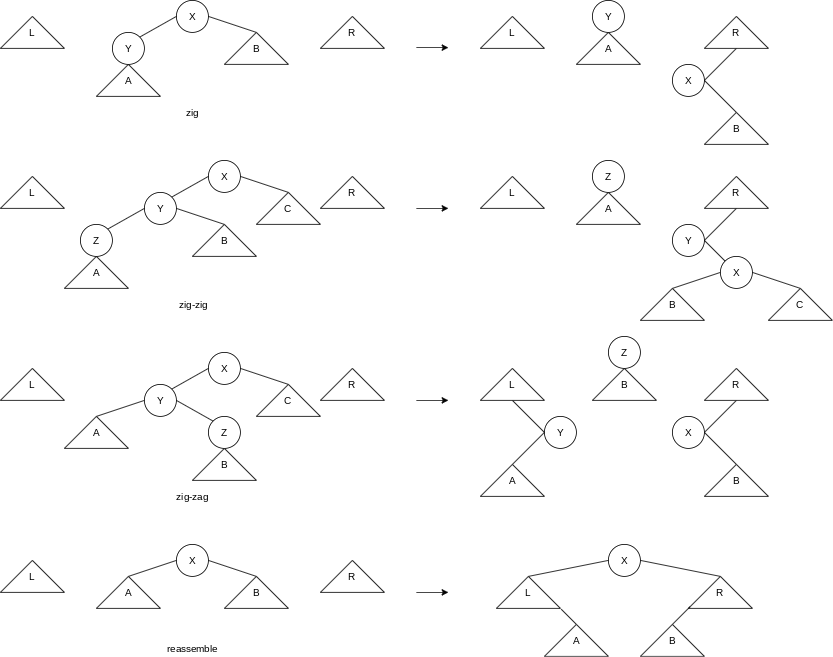
The zig-zag step can be simplified somewhat because no rotations are performed. Instead of making

We attempt to access 19 in the tree.
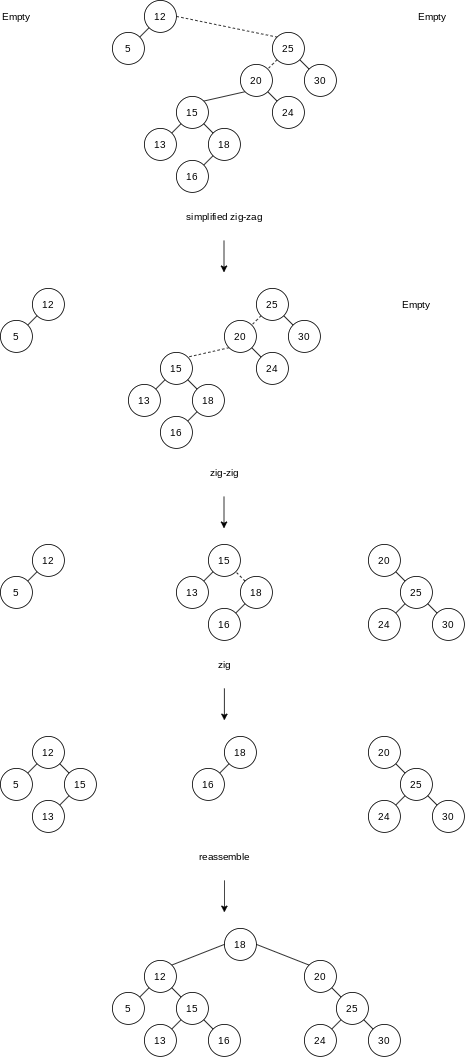
public class SplayTree<AnyType extends Comparable<? super AnyType>> {
private BinaryNode<AnyType> root;
private BinaryNode<AnyType> nullNode;
private BinaryNode<AnyType> header = new BinaryNode<>(null);
private BinaryNode<AnyType> newNode = null;
public SplayTree() {
nullNode = new BinaryNode<>(null);
nullNode.left = nullNode.right = nullNode;
root = nullNode;
}
private BinaryNode<AnyType> splay(AnyType x, BinaryNode<AnyType> t) {
BinaryNode<AnyType> leftTreeMax, rightTreeMin;
header.left = header.right = nullNode;
leftTreeMax = rightTreeMin = header;
nullNode.element = x;
for (;;)
if (x.compareTo(t.element) < 0) {
if (x.compareTo(t.left.element) < 0)
t = rotateWithLeftChild(t);
if (t.left == nullNode)
break;
rightTreeMin.left = t;
rightTreeMin = t;
t = t.left
} else if (x.compareTo(t.element) > 0) {
if (x.compareTo(t.right.element) > 0)
t = rotateWithRightChild(t);
if (t.right == nullNode)
break;
leftTreeMax.right = t;
leftTreeMax = t;
t = t.right;
} else
break;
leftTreeMax.right = t.left;
rightTreeMin.left = t.right;
t.left = header.right;
t.right = header.left;
return t;
}
public void insert(AnyType x) {
if (newNode == null)
newNode = newBinaryNode<>(null);
newNode.element = x;
if (root == nullNode) {
newNode.left = newNode.right = nullNode;
root = newNode;
} else {
root = splay(x, root);
if (x.compareTo(root.element) < 0) {
newNode.left = root.left;
newNode.right = root;
root.left = nullNode;
root = newNode;
} else if (x.compareTo(root.element) > 0) {
newNode.right = root.right;
newNode.left = root;
root.right = nullNode;
root = newNode;
} else
return ;
}
newNode = null;
}
public void remove(AnyType x) {
BinaryNode<AnyType> newTree;
root = splay(x, root);
if (root.element.compareTo(x) != 0)
return ;
if (root.left == nullNode)
newTree = root.right;
else {
newTree = root.left;
newTree = splay(x, newTree);
newTree.right = root.right;
}
root = newTree;
}
public AnyType findMin() {
...
}
public AnyType findMax() {
...
}
public boolean contains(AnyType x) {
...
}
public void makeEmpty() {
root = nullNode;
}
public boolean isEmpty() {
return root == nullNode;
}
private BinaryNode<AnyType> rotateWithLeftChild(BinaryNode<AnyType> k2) {
...
}
private BinaryNode<AnyType> rotateWithRightChild(BinaryNode<AnyType> k1) {
...
}
}12.2 Red-Black Trees
A red-black tree is a binary search tree with the following coloring properties:
- Every node is colored either red or black.
- The root is black.
- If a node is red, its children must be black.
- Every path from a node to a null reference must contain the same number of black nodes.
A consequence of the coloring rules is that the height of a red-black tree is at most
The difficulty, as usual, is inserting a new item into the tree. If we color this item black, then we are certain to violate condition
12.2.1 Bottom-Up Insertion
If the parent of the newly inserted item is black, we are done.
There are several cases (each with a mirror image symmetry) to consider if the parent is red. First, suppose that the sibling of the parent is black (we adopt the convention that null nodes are black).
Let
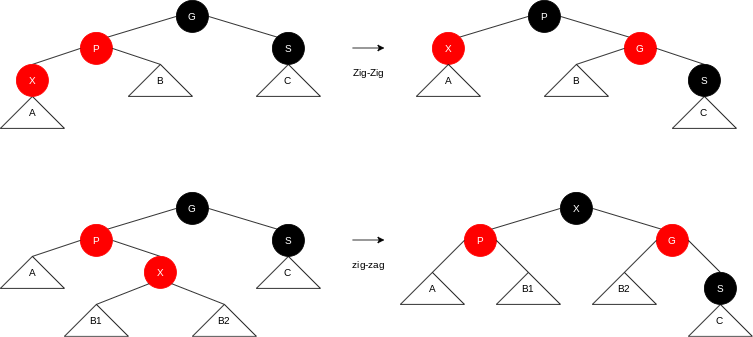
But what happens if S is red? If there is one black node on the path from the subtree’s root to
12.2.2 Top-Down Red-Black Trees
We saw that splay trees are more efficient if we use a top-down procedure, and it turns out that we can apply a top-down procedure to red-black trees that guarantees that
The procedure is conceptually easy. On the way down, when we see a node
public class RedBlackTree<AnyType extends Comparable<? super AnyType>> {
private RedBlackNode<AnyType> header;
private RedBlackNode<AnyType> nullNode;
private static final int BLACK = 1;
private static final int RED = 0;
private RedBlackNode<AnyType> current;
private RedBlackNode<AnyType> parent;
private RedBlackNode<AnyType> grand;
private RedBlackNode<AnyType> great;
public RedBlackTree() {
nullNode = new RedBlackNode<>(null);
nullNode.left = nullNode.right = nullNode;
header = new RedBlackNode<>(null);
header.left = header.right = nullNode;
}
private static class RedBlackNode<AnyType> {
AnyType element;
RedBlackNode<AnyType> left;
RedBlackNode<AnyType> right;
int color;
RedBlackNode(AnyType theElement) {
this(thisElement, null, null);
}
RedBlackNode(AnyType theElement, RedBlackNode<AnyType> lt, RedBlackNode<AnyType rt) {
element = theElement;
left = lt;
right = rt;
color = RedBlackTree.BLACK;
}
}
private RedBlackNode<AnyType> rotate(AnyType item, RedBlackTree<AnyType> parent) {
if (compare(item, parent) < 0)
return parent.left = compare(item, parent.left) < 0 ? rotateWithLeftChild(parent.left) : rotateWithRightChild(parent.left);
else
return parent.right = compare(item, parent.right) < 0 ? rotateWithLeftChild(parent.right) : rotateWithRightChild(parent.right);
}
private final int compare(AnyType item, RedBlackNode<AnyType> t) {
if (t == header)
return 1;
else
return item.compareTo(t.element);
}
private void handleReorient(AnyType item) {
current.color = RED;
current.left.color = BLACK;
current.right.color = BLACK;
if (parent.color == RED) {
grand.color = RED;
if ((compare(item, grand) < 0) != (compare(item, parent) < 0))
parent = rotate(item, grand);
current = rotate(item, great);
current.color = BLACK;
}
header.right.color = BLACK;
}
public void insert(AnyType item) {
current = parent = grand = header;
nullNode.element = item;
while (compare(item, current) != 0) {
great = grand;
grand = parent;
parent = current;
current = compare(item, current) < 0 ? current.left : current.right;
if (current.left.color == RED && current.right.color == RED)
handleReorient(item);
}
if (current != nullNode)
return ;
current = new RedBlackNode<>(item, nullNode, nullNode);
if (compare(item, parent) < 0)
parent.left = current;
else
parent.right = current;
handleReorient(item);
}
public void printTree() {
if (isEmpty())
System.out.println("Empty tree");
else
printTree(header.right);
}
public void printTree(RedBlackNode<AnyType> t) {
if (t != nullNode) {
printTree(t.left);
System.out.println(t.element);
printTree(t.right);
}
}
}12.2.3 Top-Down Deletion
Deletion in red-black trees can also be performed top-down. Everything boils down to being able to delete a leaf. This is because to delete a node that has two children, we replace it with the smallest node in the right subtree; that node, which must have at most one child, is then deleted. Nodes with only a right child can be deleted in the same manner, while nodes with only a left child can be deleted by replacement with the largest node in the left subtree, and subsequent deletion of that node.
Deletion of a red leaf is, of course, trivial. If a leaf is black, however, the deletion is more complicated because removal of a black node will violate condition
Let
First, suppose
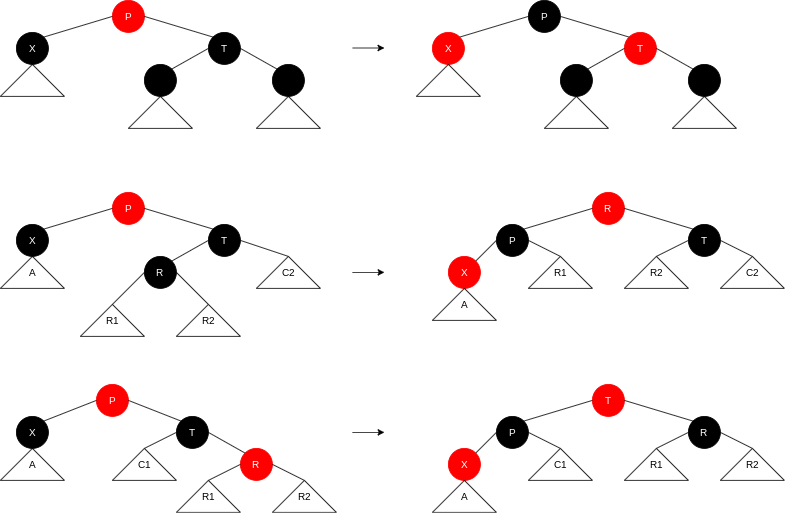
Otherwise, one of
12.3 Treaps
Each node in the tree stores an item, a left and right link, and a priority that is randomly assigned when the node
is created. A treap is a binary search tree with the property that the node priorities satisfy heap order: Any node’s priority must be at least as large as its parent’s.
12.4 Suffix Arrays and Suffix Trees
Suffix array and suffix tree sounds like two data structures, but as we will see, they are basically equivalent, and trade time for space.
12.4 Suffix Arrays and Suffix Trees
A suffix array for a text

If
We can also use the suffix array to find the number of occurrences of
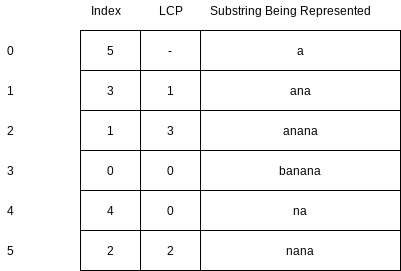
public static int computeLCP(String s1, String s2) {
int i = 0;
while (i < s1.length() && i < s2.length() && s1.charAt(i) == s2.charAt(i))
i++;
return i;
}
public static void createSuffixArray(String str, int[] SA, int[] LCP) {
if (SA.length != str.length() | LCP.length != str.length())
throw new IllegalArgumentException();
int N = str.length();
String[] suffixes = new String[N];
for (int i = 0; i < N; i++)
suffixes[i] = str.substring(i);
Arrays.sort(suffixes);
for (int i = 0; i < N; i++)
SA[i] = N - suffixes[i].length();
LCP[0] = 0;
for (int i = 1; i < N; i++)
LCP[i] = computeLCP(suffixes[i - 1], suffixes[i]);
}12.4.2 Suffix Trees
Suffix arrays are easily searchable by binary search, but the binary search itself automatically implies
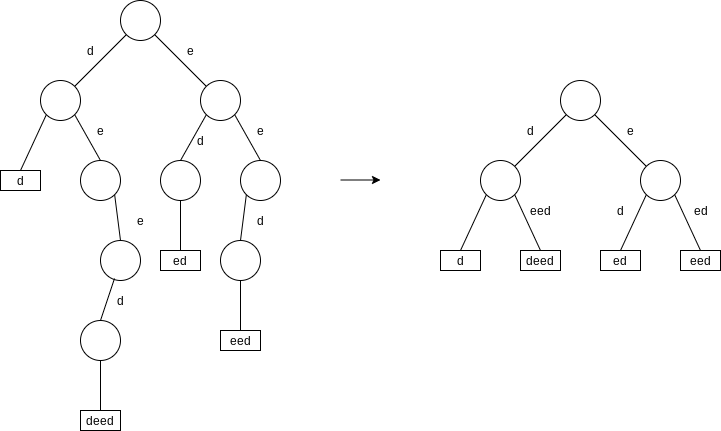
This representation could waste significant space if there are many nodes that have only one child. We see an equivalent representation on the right, known as a compressed trie. Notice that although the branches now have multicharacter labels, all the labels for the branches of any given node must have unique first characters. Thus it is still just as easy as before to choose which branch to take. Thus we can see that a search for a pattern
If the original string has length
- In the leaves, we use the index where the suffix begins (as in the suffix array).
- In the internal nodes, we store the number of common characters matched from the root until the internal node; this number represents the letter depth.
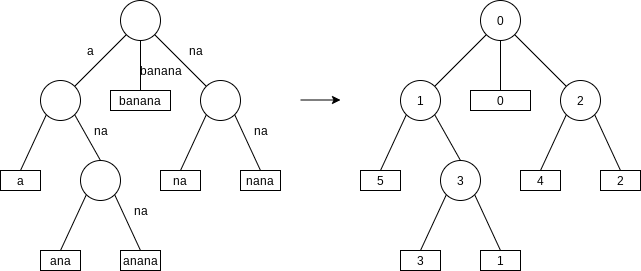
In fact, this analysis makes clear that a suffix tree is equivalent to a suffix array plus an LCP array.
At that time we can compute the LCP as follows: If the suffix node value PLUS the letter depth of the parent is equal to
12.4.3 Linear-Time Construction of Suffix Arrays and Suffix Trees
We describe an
- Choose a sample
of suffixes. - Sort the sample
by recursion. - Sort the remaining suffixes,
, by using the now-sorted sample of suffixes . - Merge
and .
We adopt the following conventions:
: represents the th character of string : represents the suffix of starting at index : represents an array
Step 1
Sort the characters in the string, assigning them numbers sequentially starting at

Step 2
Divide the text into three groups:
The idea is that each of
S_2 &= [RAC], [ADA], [BRA]
\end{align}
$$
Step 3
Concatenate
$$
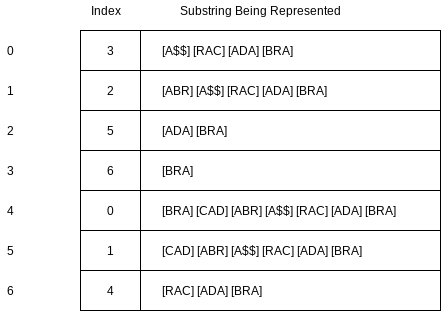
Notice that these are not exactly the same as the corresponding suffixes in
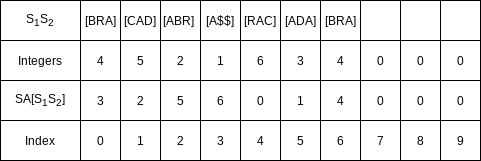
Step 4
Compute the suffix array for
Since our recursive call has already sorted all
From the recursive call in step 3, we can rank the suffixes in
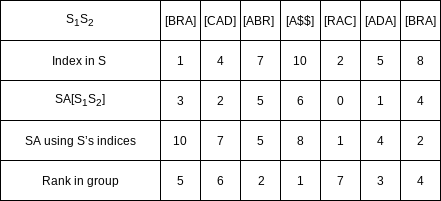
The ranking established in
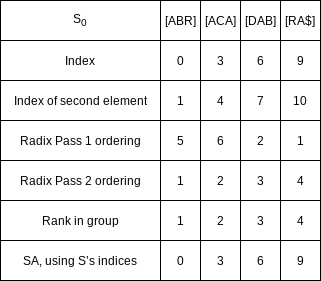
Step 5
Merge the two suffix arrays using the standard algorithm to merge two sorted lists. The only issue is that we must be able to compare each suffix pair in constant time.
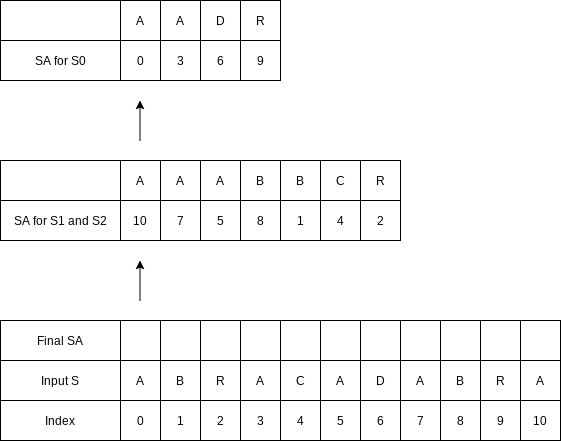
The first comparison is between index
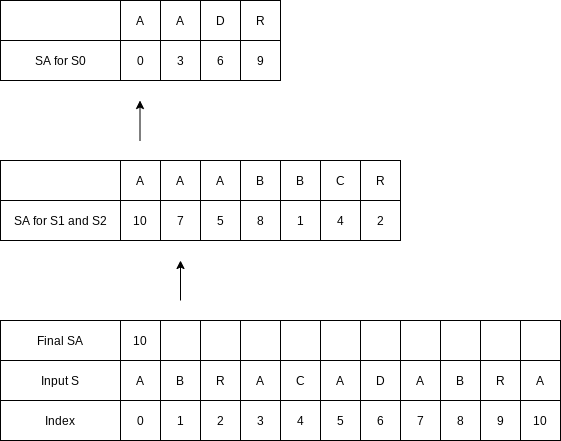
Again the first characters match, so we compare indices
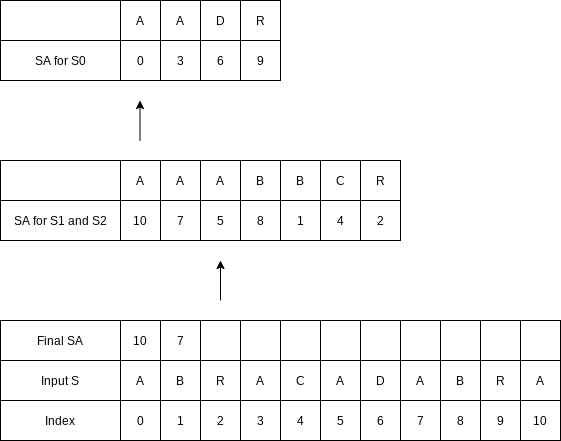
Once again, the first characters match, so now we have to compare indices
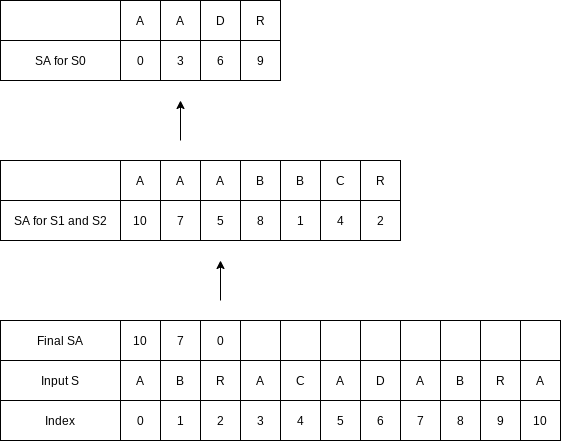
The same situation occurs on the next comparison.
public static void createSuffixArray(String str, int[] sa, int[] LCP) {
if (sa.length != str.length() || LCP.length != str.length())
throw new IllegalArgumentException();
int N = str.length();
int[] s = new int[N + 3];
int[] SA = new int[N + 3];
for (int i = 0; i < N; i++)
s[i] = str.charAt(i);
makeSuffixArray(s, SA, N, 256);
for (int i = 0; i < N; i++)
sa[i] = SA[i];
makeLCPArray(s, sa, LCP);
}
public static void makeSuffixArray(int[] s, int[] SA, int n, int K) {
int n0 = (n + 2) / 3;
int n1 = (n + 1) / 3;
int n2 = n / 3;
int t = n0 - n1;
int n12 = n1 + n2 + t;
int[] s12 = new int[n12 + 3];
int[] SA12 = new int[n12 + 3];
int[] s0 = new int[n0];
int[] SA0 = new int[n0];
for (int i = 0; j = 0; i < n + t; i++)
if (i % 3 != 0)
s12[j++] = i;
int K12 = assignNames(s, s12, SA12, n0, n12, K);
computeS12(s12, SA12, n12, K12);
computeS0(s, s0, SA0, SA12, n0, n12, K);
merge(s,s12, SA, SA0, SA12, n, n0, n12, t);
}
private static int assignNames(int[] s, int[] s12, int[] SA12, int n0, int n12, int K) {
radixPass(s12, SA12, s, 2, n12, K);
radixPass(SA12, s12, s, 1, n12, K);
radixPass(s12, SA12, s, 0, n12, K);
int name = 0;
int c0 = -1, c1 = -1, c2 = -1;
for (int i = 0; i < n12; i++) {
if (s[SA12[i]] != c0 || s[SA12[i] + 1] != c1 || s[SA12[i] + 2] != c2) {
name++;
c0 = s[SA12[i]];
c1 = s[SA12[i] + 1];
c2 = s[SA12[i] + 2];
}
if (SA12[i] % 3 == 1)
s12[SA12[i] / 3] = name;
else
s12[SA12[i] / 3 + n0] = name;
}
return name;
}
private static void radixPass(int[] in, int[] out, int[] s, int offset, int n, int K) {
int[] count = new int[K + 2];
for (int i = 0; i < n; i++)
count[s[in[i] + offset] + 1]++;
for (int i = 1; i <= K + 1; i++)
count[i] += count[i - 1];
for (int i = 0; i < n; i++)
out[count[s[in[i] + offset]]++] = in[i];
}
private static void radixPass(int[] in, int[] out, int[] s, int n, int K) {
radixPass(in, out, s, 0, n, K);
}
private static void computeS12(int[] s12, int[] SA12, int n12, int K12) {
if (K12 == n12)
for (int i = 0; i < n12; i++)
SA12[s12[i] - 1] = i;
else {
makeSuffixArray(s12, SA12, n12, K12);
for (int i = 0; i < n12; i++)
s12[SA12[i]] = i + 1;
}
}
private static void computeS0(int[] s, int[] s0, int[] SA0, int[] SA12, int n0, int n12, int K) {
for (int i = 0, j = 0; i < n12; i++)
if (SA12[i] < n0)
s0[j++] = 3 * SA12[i];
radixPass(s0, SA0, s, n0, K);
}
private static void merge(int[] s, int[] s12, int[] SA, int[] SA0, int[] SA12, int n, int n0, int n12, int t) {
int p = 0, k = 0;
while (t != n12 && p != n0) {
int i = getIndexIntoS(SA12, t, n0);
int j = SA0[p];
if (suffix12IsSmaller(s, s12, SA12, n0, i, j, t)) {
SA[k++] = i;
t++;
} else {
SA[k++] = j;
p++;
}
}
while (p < n0)
SA[k++] = SA0[p++];
while (t < n12)
SA[k++] = getIndexIntoS(SA12, t++, n0);
}
private static int getIndexIntoS(int[] SA12, int t, int n0) {
if (SA12[t] < n0)
return SA[t] * 3 + 1;
else
return (SA12[t] - n0) * 3 + 2;
}
private static boolean leq(int a1, int a2, int b1, int b2) {
return a1 < b1 || a1 == b1 && a2 <= b2;
}
private static boolean leq(int a1, int a2, int a3, int b1, int b2, int b3) {
return a1 < b1 || a1 == b1 && leq(a2, a3, b2, b3);
}
private static boolean suffix12IsSmaller(int[] s, int[] s12, int[] SA12, int n0, int i, int j, int t) {
if (SA12[t] < n0)
return leq(s[i], s12[SA12[t] +n0], s[j], s12[j / 3]);
else
return leq(s[i]], s[i + 1], s12[SA12[t] - n0 + 1], s[j], s[j + 1], s12[j / 3 + n0]);
}12.5
The two-dimensional search tree has the simple property that branching on odd levels is done with respect to the first key, and branching on even levels is done with respect to the second key. The root is arbitrarily chosen to be an odd level.

As we go down the tree, we need to maintain the current level. One difficulty is duplicates, particularly since several items can agree in one key.
public void insert(AnyType[] x) {
root = insert(x, root, 0);
}
private KdNode<AnyType> insert(AnyType[] x, kdNode<AnyType> t, int level) {
if (t == null)
t = new KdNode<>(x);
else if (x[level].compareTo(t.data[level]) < 0)
t.left = insert(x, t.left, 1 - level);
else
t.right = insert(x, t.right, 1 - level);
return t;
}A moment’s thought will convince you that a randomly constructed
Unlike binary search trees, for which clever
We can ask for an exact match, or a match based on one of the two keys; the latter type of request is a partial match query. Both of these are special cases of an (orthogonal) range query.
A range query is easily solved by a recursive tree traversal.
/**
* low[0] <= x[0] <= high[0] and low[1] <= x[1] <= high[1]
*/
public void printRange(AnyType[] low, AnyType[] high) {
print(low, high, root, 0);
}
private void printRange(AnyType[] low, AnyType[] high, KdNode<AnyType> t, int level) {
if (t != null) {
if (low[0].compareTo(t.data[0]) <= 0 && low[1].compareTo(t.data[1]) <= 0 && high[0].compareTo(t.data[0]) >= 0 && high[1].compareTo(t.data[1]) >= 0)
System.out.println("(" + t.data[0] + "," + t.data[1] + ")");
if (low[level].compareTo(t.data[level]) <= 0)
printRange(low, high, t.left, 1 - level);
if (high[level].compareTo(t.data[level]) >= 0)
printRange(low, high, t.right, 1 - level);
}
}To find a specific item, we can set low equal to high equal to the item we are searching for. To perform a partial match query, we set the range for the key not involved in the match to
For a perfectly balanced tree, a range query could take
For a randomly constructed tree, the average running time of a partial match query is
For
12.6 Pairing Heaps
The pairing heap is represented as a heap-ordered tree. The actual pairing heap implementation uses a left child, right sibling representation.
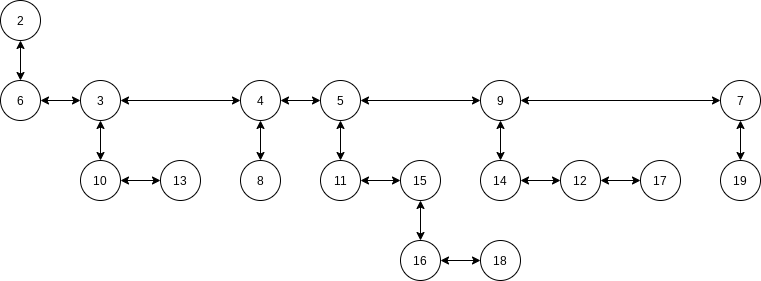
To merge two pairing heaps, we make the heap with the larger root a left child of the heap with the smaller root. Insertion is, of course, a special case of merging. To perform a decreaseKey, we lower the value in the requested node. Because we are not maintaining parent links for all nodes, we don’t know if this violates the heap order. Thus we cut the adjusted node from its parent and complete the decreaseKey by merging the two heaps that result. To perform a deleteMin, we remove the root, creating a collection of heaps. If there are
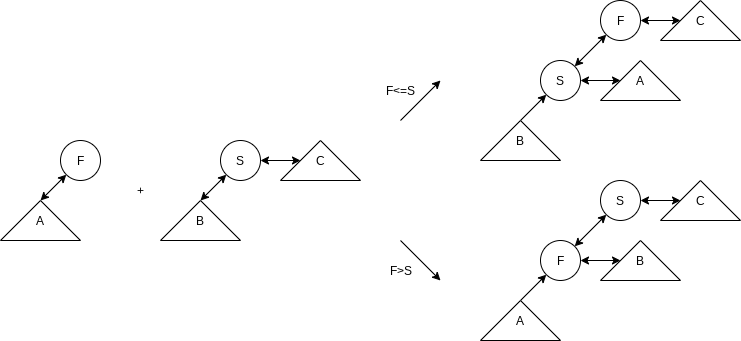
public class PairingHeap<AnyType extends Comparable<? super AnyType>> {
private PairNode<AnyType> root;
private int theSize;
private PairNode<AnyType>[] treeArray = new PairNode[5];
public interface Position<AnyType> {
AnyType getValue();
}
private static class PairNode<AnyType> implements Position<AnyType> {
public AnyType element;
public PairNode<AnyType> leftChild;
public PairNode<AnyType> nextSibling;
public PairNode<AnyType> prev;
public PairNode(AnyType theElement) {
element = theElement;
leftChild = nextSibling = prev = null;
}
public AnyType getValue() {
return element;
}
}
private PairNode<AnyType> compareAndLink(PairNode<AnyType> first, PairNode<AnyType> second) {
if (second == null)
return first;
if (second.element.compareTo(first.element) < 0) {
second.prev = first.prev;
first.prev = second;
first.nextSibling = second.leftChild;
if (first.nextSibling != null)
first.nextSibling.prev = first;
second.leftChild = first;
return second;
} else {
second.prev = first;
first.nextSibling = second.nextSibling;
if (first.nextSibling != null)
first.nextSibling.prev = first;
second.nextSibling = first.leftChild;
if (second.nextSibling != null)
second.nextSibling.prev = second;
first.leftChild = second;
return first;
}
}
private PairNode<AnyType> combineSiblings(PairNode<AnyType> firstSibling) {
if (firstSibling.extSibling == null)
return firstSibling;
int numSiblings = 0;
for (; firstSibling != null; numSiblings++) {
treeArray = doubleIfFull(treeArray, numSiblings);
treeArray[numSiblings] = firstSibling;
firstSibling.prev.nextSibling = null;
firstSibling = firstSibling.nextSibling;
}
treeArray = doubleIfFull(treeArray, numSiblings);
treeArray[numSiblings] = null;
int i = 0;
for (; i + 1 < numSiblings; i += 2)
treeArray[i] = compareAndLink(treeArray[i], treeArray[i + 1]);
int j = i - 2;
if (j == numSiblings - 3)
treeArray[j] = compareAndLink(treeArray[j], treeArray[j + 2]);
for (; j >= 2; j -= 2)
treeArray[j - 2] = compareAndLink(treeArray[j - 2], treeArray[j]);
return (PairNode<AnyType>) treeArray[0];
}
private PairNode<AnyType>[] doubleIfFull(PairNode<AnyType>[] array, int index) {
if (index == array.length) {
PairNode<AnyType>[] oldArray = array;
array = new PairNode[index * 2];
for (int i = 0; i < index; i++)
array[i] = oldArray[i];
}
return array;
}
public Pisition<AnyType> insert(AnyType x) {
PairNode<AnyType> newNode = new PairNode<>(x);
if (root == null)
root = newNode;
else
root = compareAndLink(root, newNode);
theSize++;
return newNode;
}
public void decreaseKey(Position<AnyType> pos, AnyType newVal) {
PairNode<AnyType> p = (PairNode<AnyType>) pos;
if (p == null || p.element == null || p.element.compareTo(newVal) < 0)
throw new IlleagalArgumentException();
p.element = newVal;
if (p != root) {
if (p.nextSibling != null)
p.nextSibling.prev = p.prev;
if (p.prev.leftChild == p)
p.prev.leftChild = p.nextSibling;
else
p.prev.nextSibling = p.nextSibling;
p.nextSibling = null;
root = compareAndLink(root, p);
}
}
public AnyType deleteMin() {
if (isEmpty())
throw new UnderflowException();
AnyType x = findMin();
root.element = null;
if (root.leftChild == null)
root = null;
else
root = combineSiblings(root.leftChild);
theSize--;
return x;
}
}